AI Overview Analyzer & Optimizer - How To Guide
The AI Overview Analyzer & Optimizer is BrandPeek's most powerful feature for analyzing and improving your content's performance in Google AI Overview results. This tool provides comprehensive E-E-A-T analysis, identifies content gaps, and offers strategic recommendations to help you dominate AI search results.
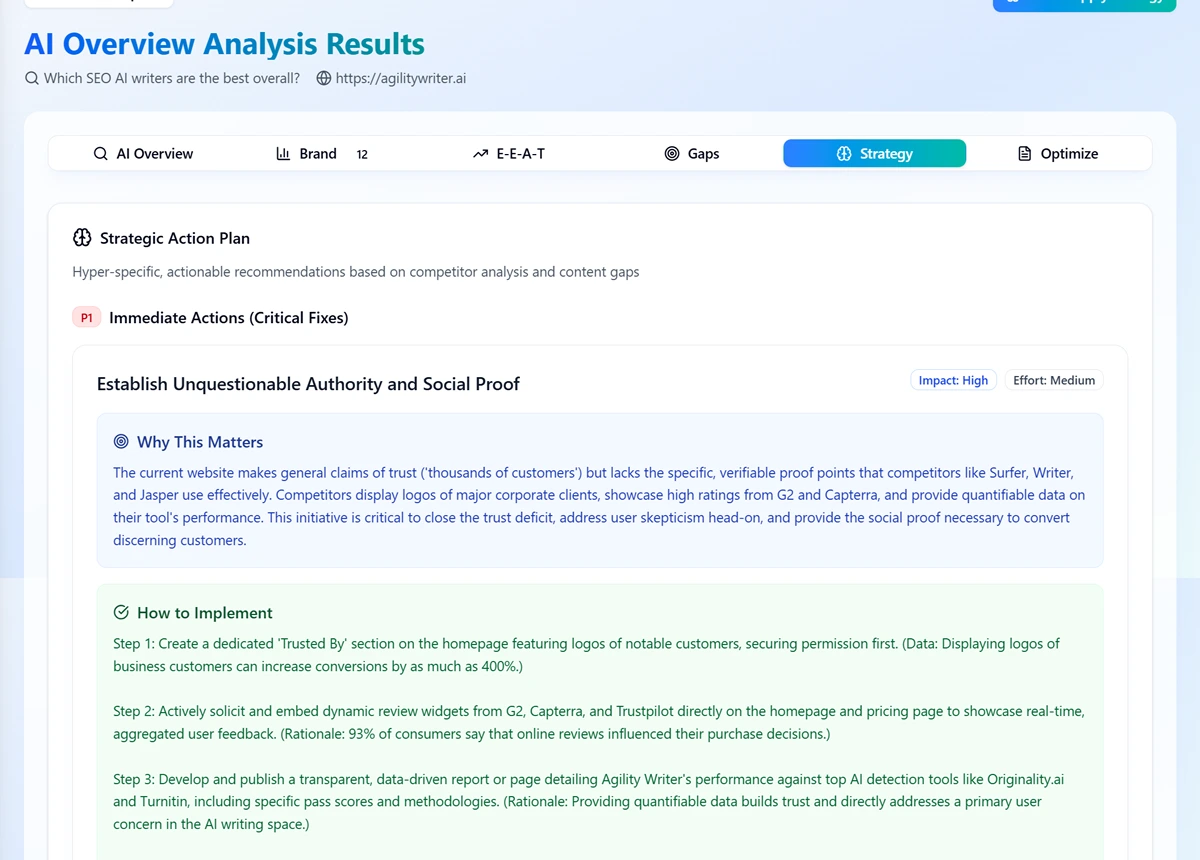
How It Works
Phase 1: Intelligence Gathering
AI Overview Extraction: Retrieves Google's AI Overview for your keyword.
Source Identification: Identifies top-cited competitor sources.
Content Scraping: Analyzes competitor content for insights.
Competitive Intelligence: Maps competitor ranking patterns.
Phase 2: Comprehensive Analysis
Content Comparison: Measures your content against top competitors.
E-E-A-T Scoring: Evaluates Experience, Expertise, Authoritativeness, and Trust.
Gap Analysis: Identifies missing topics and content elements.
Ranking Analysis: Assesses your current competitive position.
Phase 3: Strategic Recommendations
Strategy Generation: Provides data-driven optimization suggestions.
Priority Levels: Strategies categorized by impact and effort (P1 = Critical, P2 = Important, P3 = Nice to Have).
Implementation Guidance: Step-by-step instructions provided.
Impact Estimation: Predicts expected improvement from each strategy.
Phase 4: Automated Optimization (Paid Plans)
Strategy Application: Automatically implement chosen optimizations.
Content Optimization: AI-generated improvements preserving your brand voice.
Version Control: Tracks all content changes.
Quality Assurance: Ensures optimized content maintains quality and competitiveness.
Credit Costs
Analysis: 10 credits per AI Overview analysis
Auto-Apply Strategy (Paid Plans Only): 2 credits per implemented strategy
Step 1: Starting Your Analysis
Accessing the AI Overview Optimizer
Navigate to Optimize in your dashboard sidebar
Click "AI Overview" from the submenu
Click "New Analysis" button to start
Analysis Setup Form
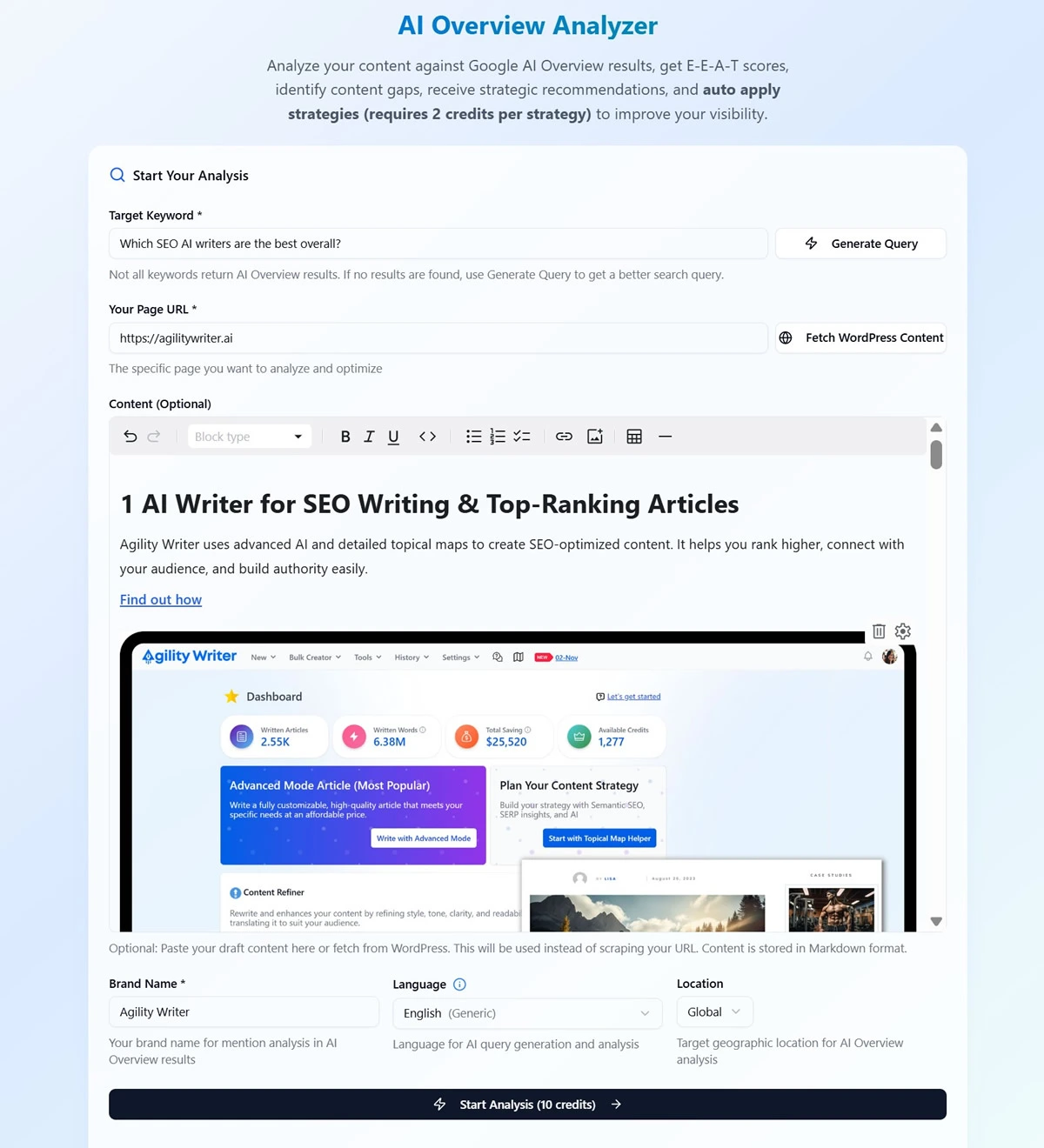
Target Keyword (Required)
Enter the keyword you want to analyze (e.g., "Which SEO AI writers are the best overall?")
Use specific, question-based queries that typically trigger AI Overview results
Click "Generate Query" if you need help creating better search queries
Your Page URL (Required)
Enter the specific page you want to analyze and optimize
This should be your most relevant content for the target keyword
Click "Fetch WordPress Content" to automatically import content from WordPress sites
Content (Optional)
Paste your draft content (recommended) or let the system scrape your URL
Content is stored in Markdown format for easy editing
This will be used for comparison against AI Overview results
Brand Name (Required)
Enter your brand name for mention analysis in AI Overview results
Language & Location
Select language for AI query generation and analysis
Choose target geographic location for AI Overview analysis
Location affects which AI Overview results are retrieved
Start Analysis
Click "Start Analysis (10 credits)" to begin the process
Analysis typically takes 5-10 minutes to complete
Step 2: Analysis Reports Dashboard
Reports List View
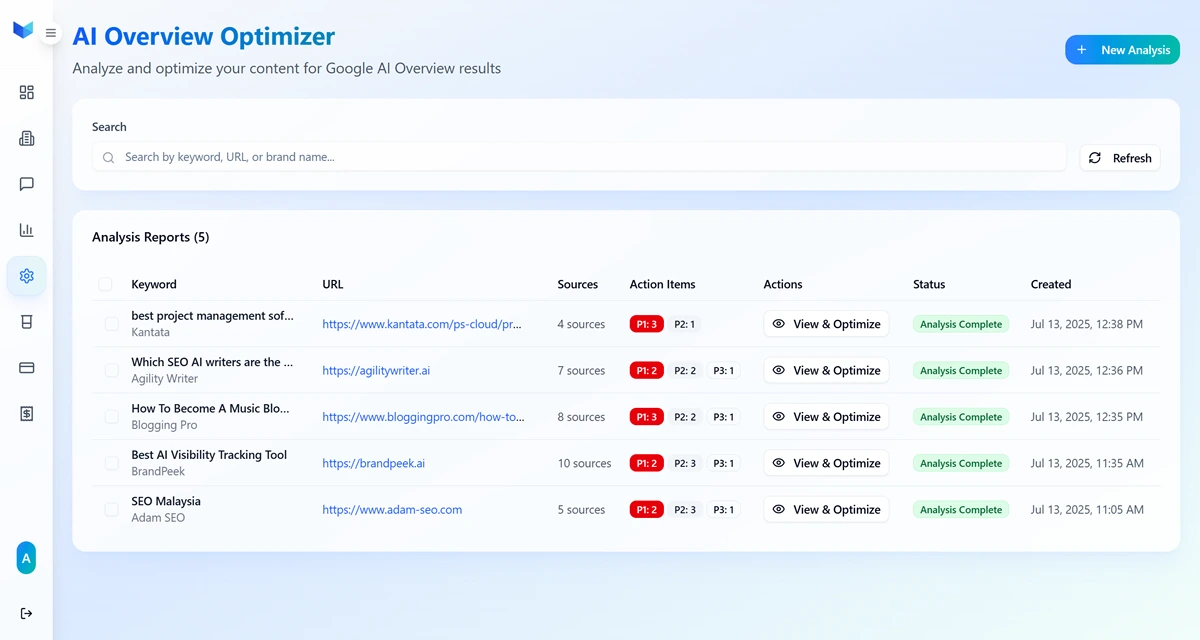
After starting an analysis, you'll see your reports in the main dashboard:
Report Information Displayed:
Keyword: The search query analyzed
URL: The page being optimized
Sources: Number of competitor sources found in AI Overview
Action Items: Number of strategic recommendations (P1/P2/P3 priority)
Status: Analysis progress (Pending, Running, Completed, Failed)
Created: When the analysis was started
Status Indicators:
Analysis Complete: Ready for review and optimization
Running: Analysis in progress
Failed: Analysis failed (automatic credit refund)
Actions Available:
View & Optimize: Access full analysis results and optimization tools
Bulk Delete: Remove multiple completed/failed analyses
Step 3: Analysis Results Overview
Navigation Tabs
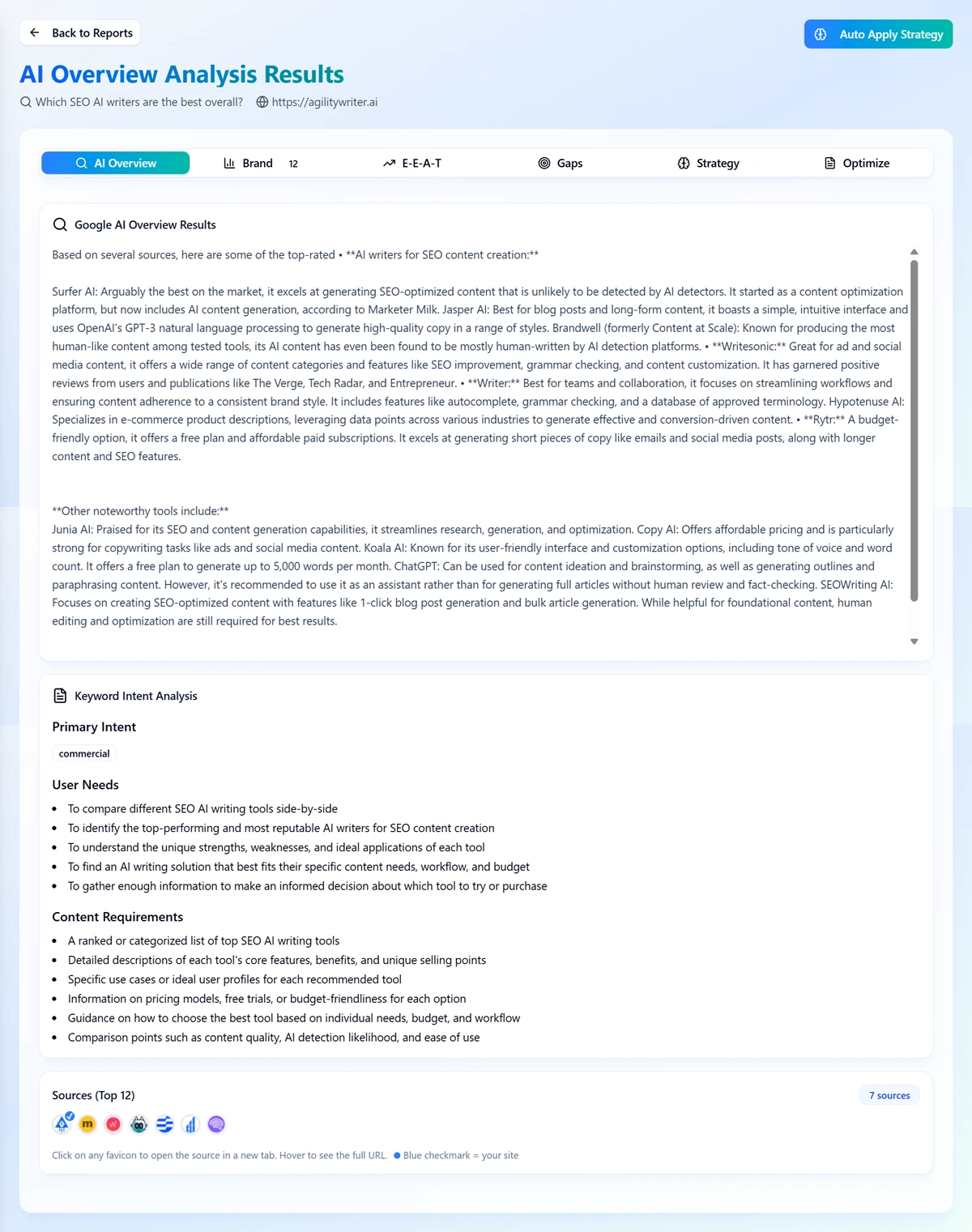
Once your analysis is complete, you'll see several tabs:
AI Overview: Google AI Overview results and analysis
Brand: Brand mention analysis (shows ranking position)
E-E-A-T: Experience, Expertise, Authoritativeness, Trust scores
Gaps: Content gap analysis and opportunities
Strategy: Strategic recommendations and action items
Optimize: Content editor for auto-apply strategy
AI Overview Tab
Google AI Overview Results
Full text of the AI Overview result for your keyword
Source citations with clickable links
Keyword intent analysis (Commercial, Informational, etc.)
User needs breakdown
Content requirements identified by AI
Sources Analysis
Top 12 sources cited in the AI Overview
Click any favicon to open the source in a new tab
Blue checkmark indicates if it's your site
Step 4: Brand Analysis
Brand Mention Analysis
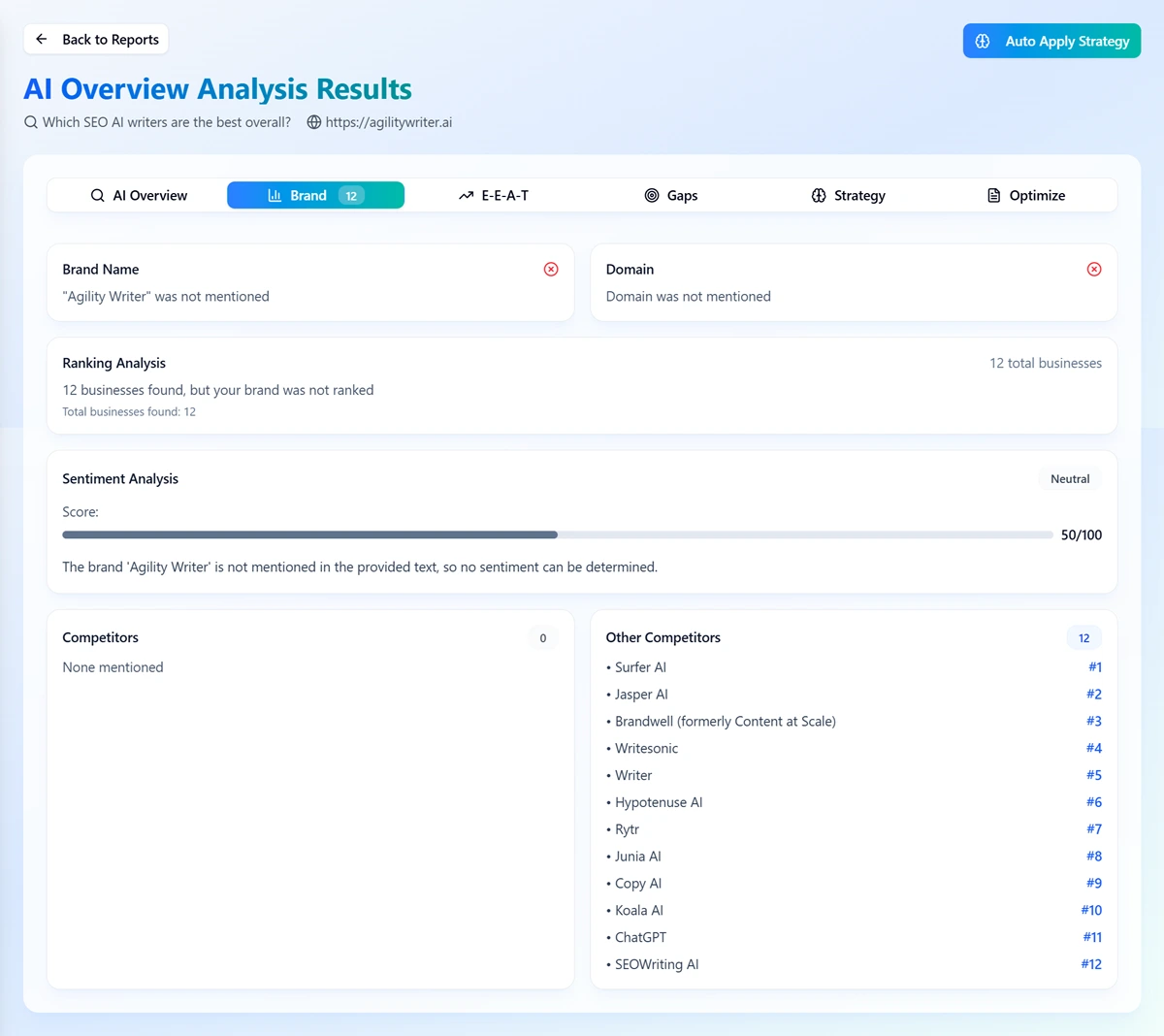
Brand Name Detection
Shows if your brand was mentioned in the AI Overview
Displays any domain mentions
Red indicators show when your brand/domain is NOT mentioned
Ranking Analysis
Total businesses found in the AI Overview
Your brand's ranking position (if mentioned)
Shows you're competing against X total businesses
Sentiment Analysis
Sentiment score (0-100 scale)
Analysis of how your brand is portrayed
Neutral score when brand isn't mentioned
Competitor Analysis
Lists all competitors mentioned in AI Overview
Shows their ranking positions (#1, #2, #3, etc.)
Identifies both known and discovered competitors
Step 5: E-E-A-T Analysis
Your Site's E-E-A-T Scores
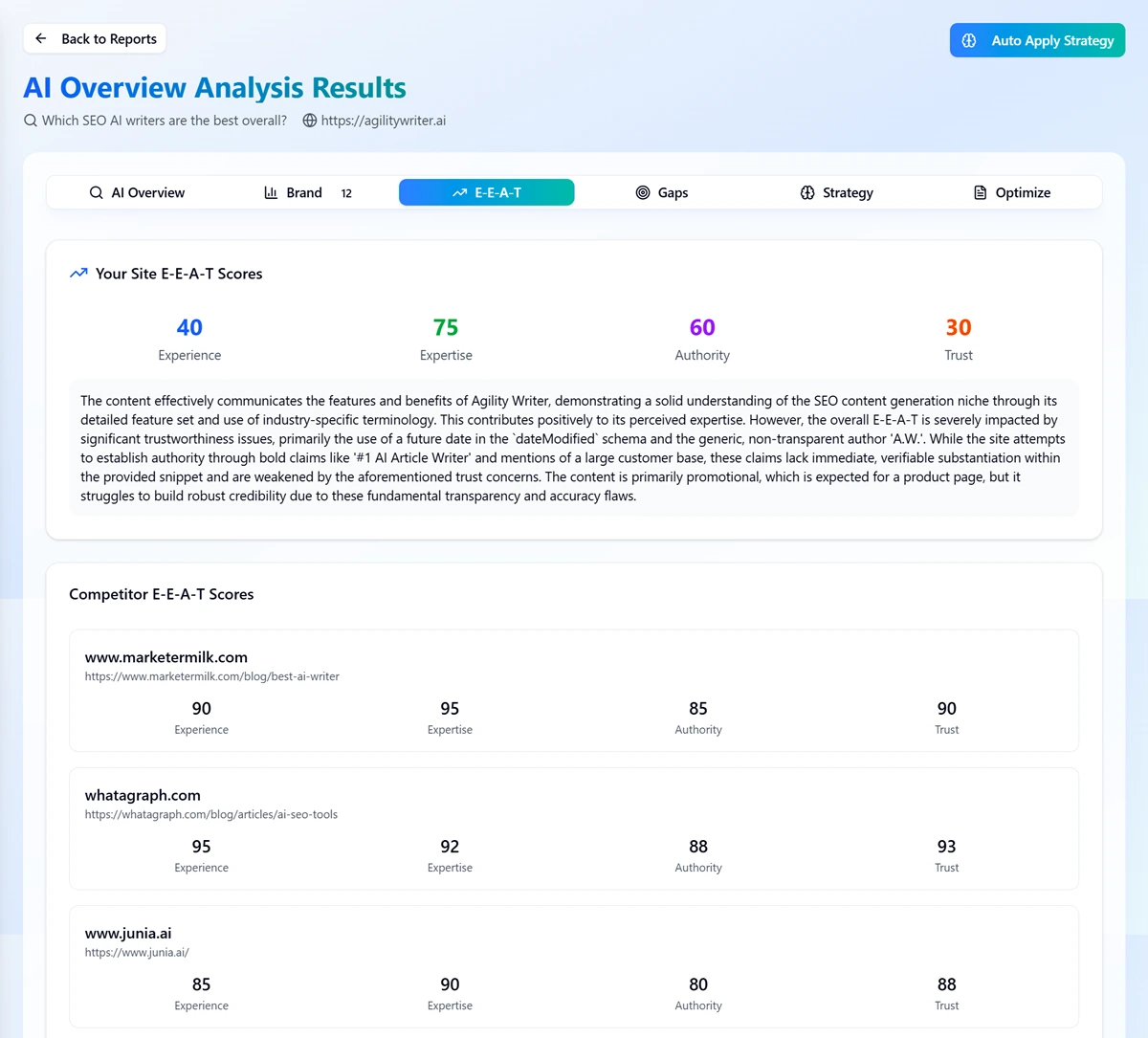
Four Key Metrics (0-100 scale):
Experience (40): First-hand experience indicators
Expertise (75): Subject matter expertise signals
Authority (60): Source credibility and citations
Trust (30): Transparency, accuracy, and reliability
Detailed Analysis
Comprehensive explanation of each score
Specific areas for improvement identified
Impact on overall E-E-A-T performance
Competitor E-E-A-T Comparison
Top Competitors Listed:
Individual E-E-A-T scores for each competitor
Direct comparison with your scores
Identifies where competitors outperform you
Shows opportunities for improvement
Step 6: Content Gap Analysis
The Content Gap Analysis identifies specific areas where your content falls short compared to competitors who rank in Google AI Overview results. This analysis helps you understand exactly what's missing or weak in your content strategy.
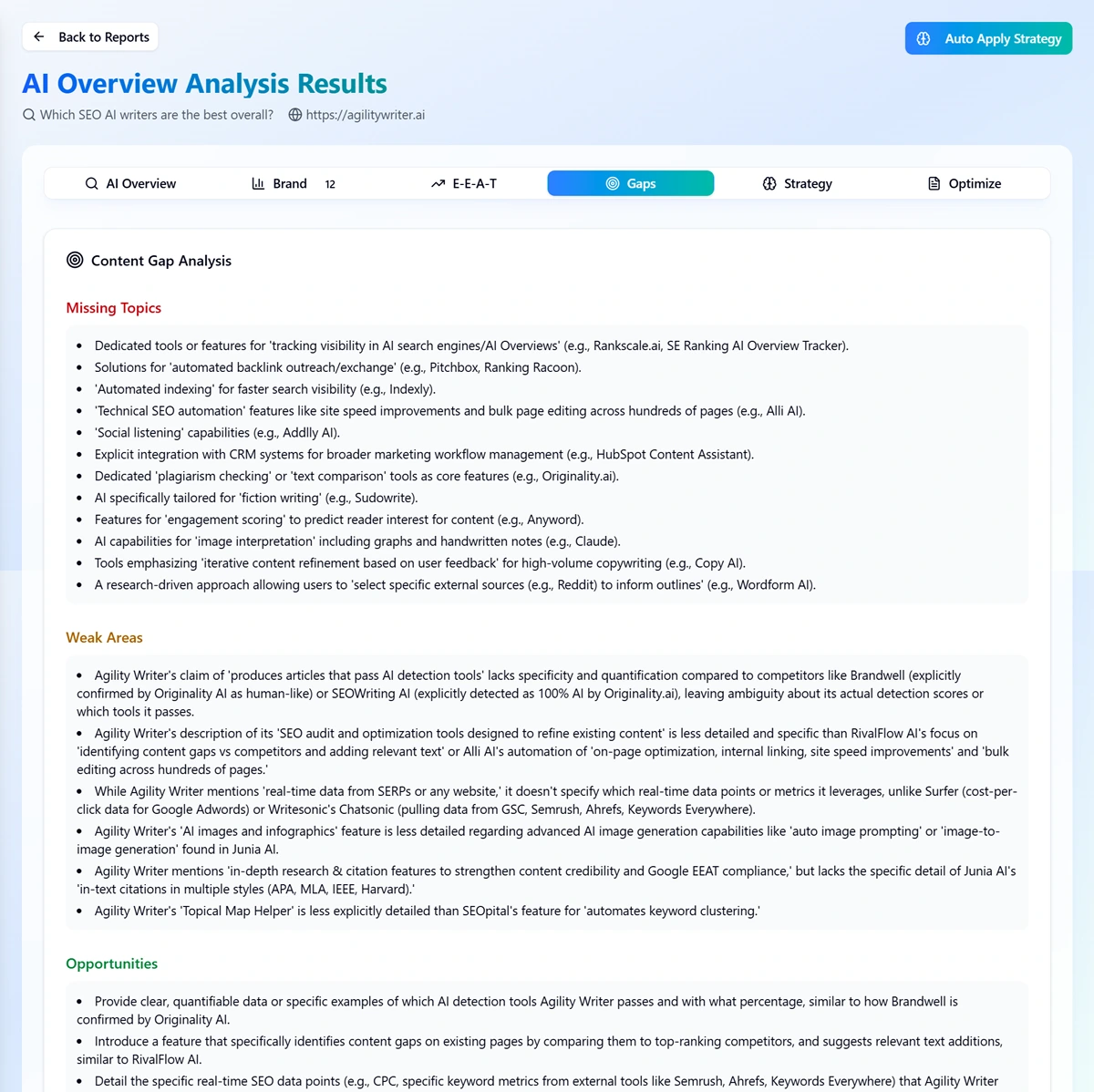
Understanding the Categories:
Missing Topics - Completely absent subjects that competitors cover
These are topics your competitors discuss that you don't address at all
Focus on these first as they represent the biggest opportunities
Each item shows specific topics found in competitor content but missing from yours
Weak Areas - Topics you cover but not as well as competitors
Areas where your content exists but lacks depth, specificity, or persuasiveness
Shows where competitors provide better explanations, more data, or stronger positioning
Indicates content that needs strengthening rather than creation
Opportunities - Actionable improvements you can make
Concrete steps to enhance your content based on competitor strengths
Specific features, data types, or strategic angles to explore
Direct suggestions for content improvements
Content Depth Gap - How competitors provide more comprehensive coverage
Explains the difference in content quality and detail level
Shows where competitors offer more strategic guidance or technical depth
Identifies areas needing more thorough explanation
Unique Angles - Distinctive approaches competitors use
Special positioning, methodologies, or market focus competitors emphasize
Differentiation opportunities you're not leveraging
Unique selling propositions that set competitors apart
Authority Signals - Trust-building elements competitors use
Credibility indicators like case studies, testimonials, expert credentials
Specific data, statistics, or proof points competitors leverage
Authority-building practices you should consider implementing
How to Prioritize:
Start with Missing Topics for quick wins
Address Weak Areas to strengthen existing content
Use Opportunities as your action plan
Apply Authority Signals to build credibility
Step 7: Strategic Recommendations
The Strategic Recommendations section provides prioritized, actionable strategies to improve your content based on the gap analysis. These are specific initiatives designed to help you outperform competitors in AI Overview results.
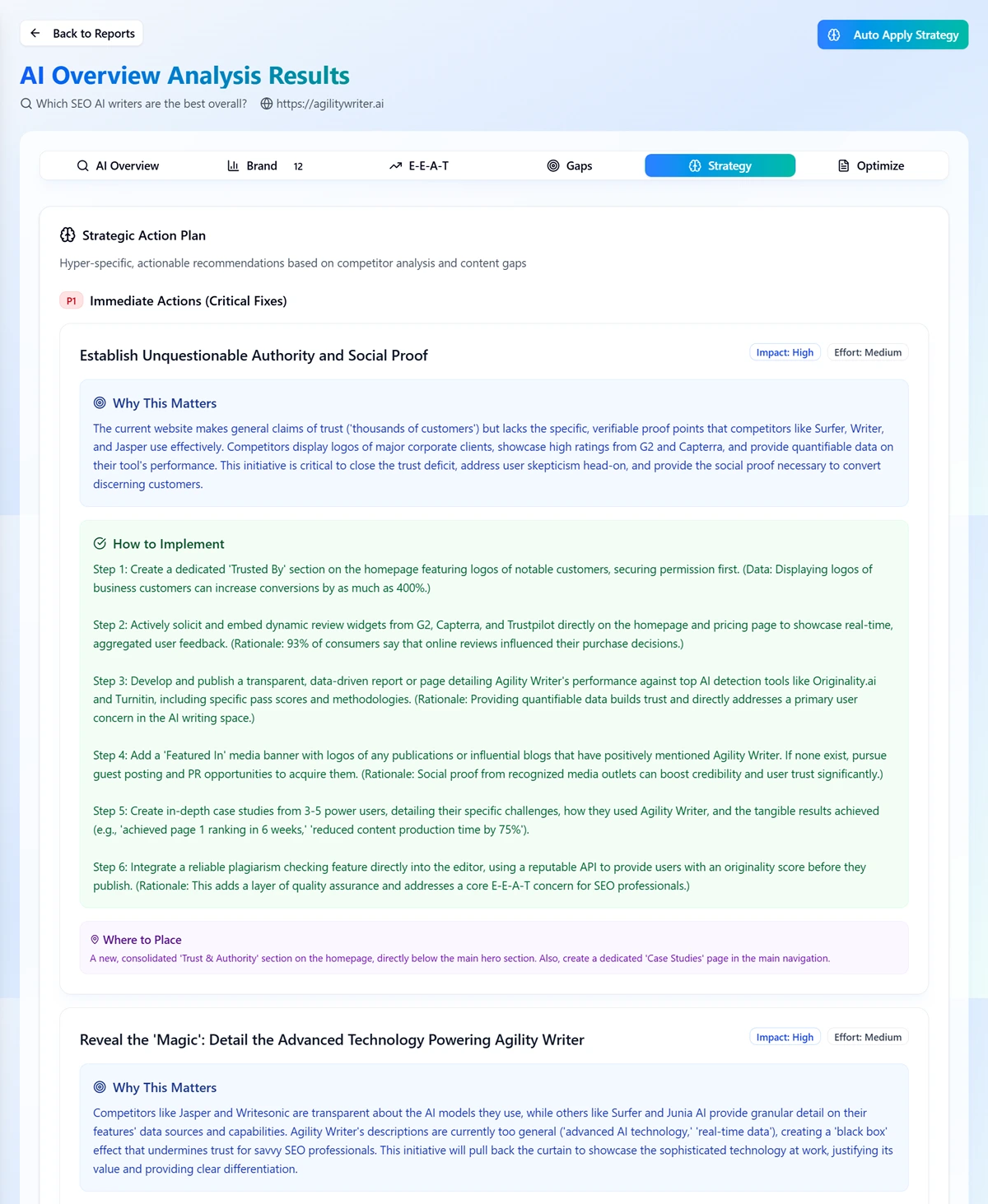
Understanding the Priority System:
P1 (Critical Priority) - High Impact, Medium Effort
Most important strategies that will significantly improve your AI Overview ranking
Focus on these first for maximum return on investment
Usually address major content gaps or missing authority signals
P2 (Important Priority) - Medium Impact, Medium Effort
Valuable improvements that enhance your competitive position
Implement after completing P1 strategies
Often involve strengthening existing content areas
P3 (Nice to Have) - Lower Impact or Higher Effort
Beneficial improvements but not critical for immediate success
Consider these for long-term content optimization
May require significant resources or provide incremental gains
Strategy Components:
Each strategy includes:
Why It Matters - The strategic rationale and expected impact
How to Implement - Step-by-step implementation guidance
Impact Level - Expected improvement to your AI Overview performance
Effort Required - Resources and time needed for implementation
Focus Areas - Specific content sections or topics to address
Implementation Approach:
Review all strategies to understand the full scope
Start with P1 strategies for immediate impact
Plan P2 strategies for medium-term implementation
Consider P3 strategies for future optimization cycles
Step 8: Strategy Application (Paid Plans Only)
The Strategy Application feature allows you to automatically implement the recommended strategies using AI-powered content optimization. This transforms your strategic recommendations into actual content improvements.
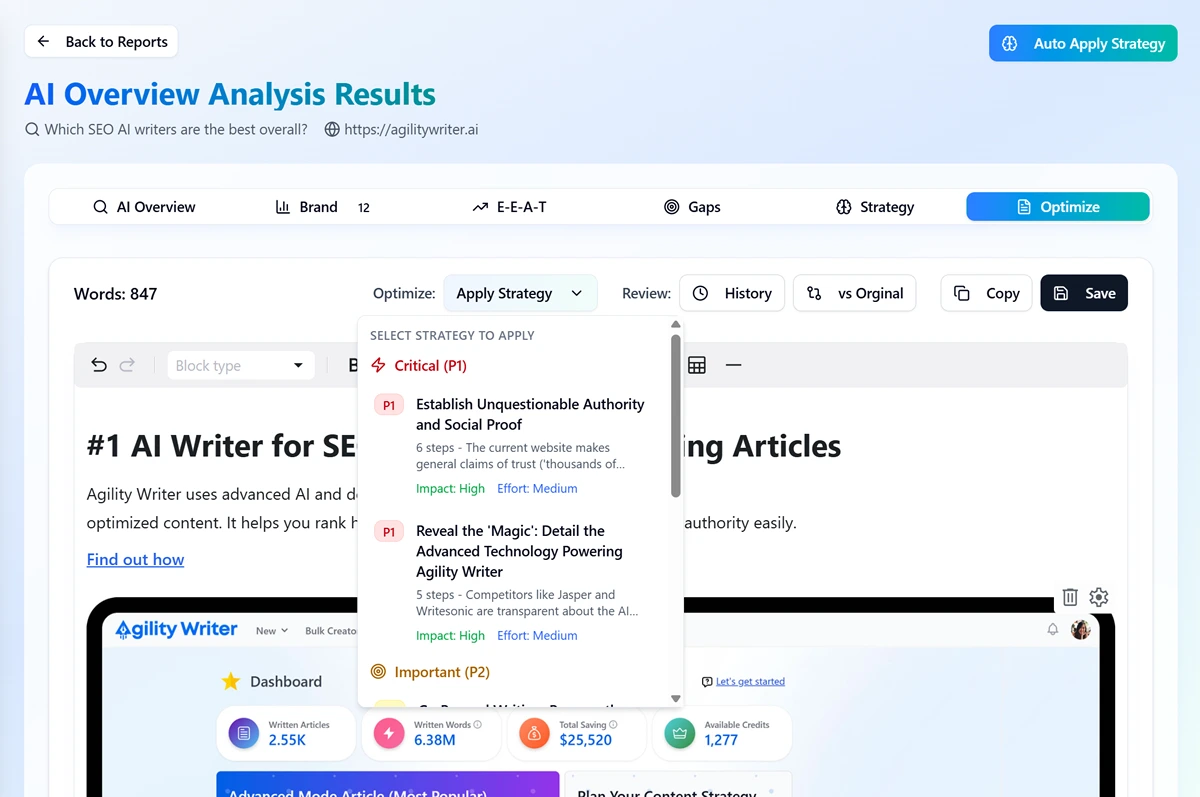
Accessing Strategy Application:
Click "Apply Strategy" on any recommendation
Note: This feature requires a paid plan subscription
Free users can view strategies but cannot use automated application
Strategy Application Process:
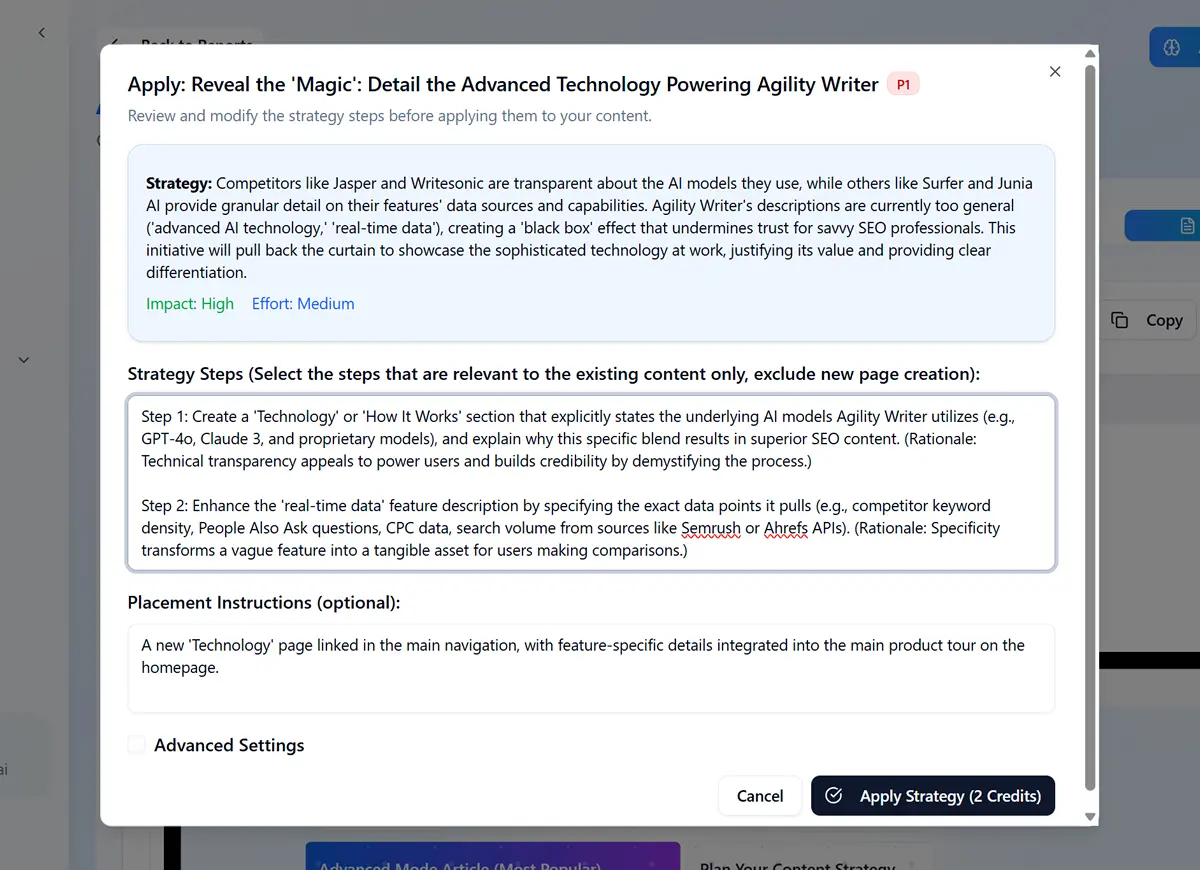
Select Strategy Steps
Review the recommended implementation steps
Edit or customize steps based on your specific needs
Add additional context or requirements
Configure Application Settings
Placement Instructions: Specify where new content should be added
Additional Instructions: Provide specific guidance for your content
Negative Terms: Words or phrases to avoid in the optimization. Click Use Common Terms to use common AI-generated terms.
Review Before Applying
Verify your current content is loaded correctly
Ensure strategy steps align with your goals
Check that you have sufficient credits (2 credits per application)
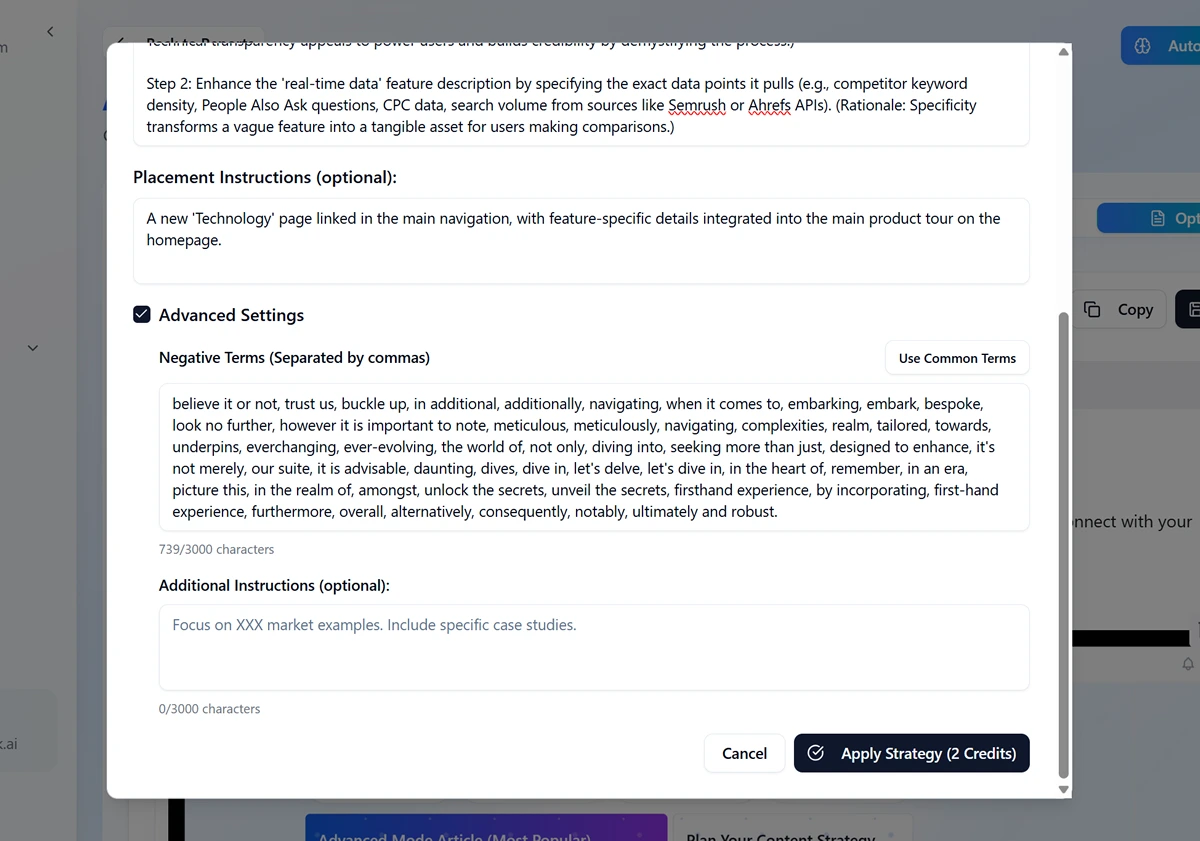
Content Editor Features:
Real-Time Editing: Make manual adjustments during or after strategy application
Version Management: Save milestones and track content history
Comparison Tools: View before/after differences
Best Practices:
Save Milestones: Always save your content as a milestone before applying strategies
Apply One at a Time: Implement strategies sequentially for better control
Review Results: Check the applied changes before moving to the next strategy
Customize Steps: Modify strategy steps to fit your specific brand voice and requirements
Credit Management:
Each strategy application costs 2 credits
Credits are deducted when you start the application
Automatic refund if the application fails
No additional charges for viewing or editing applied content
Version Control:
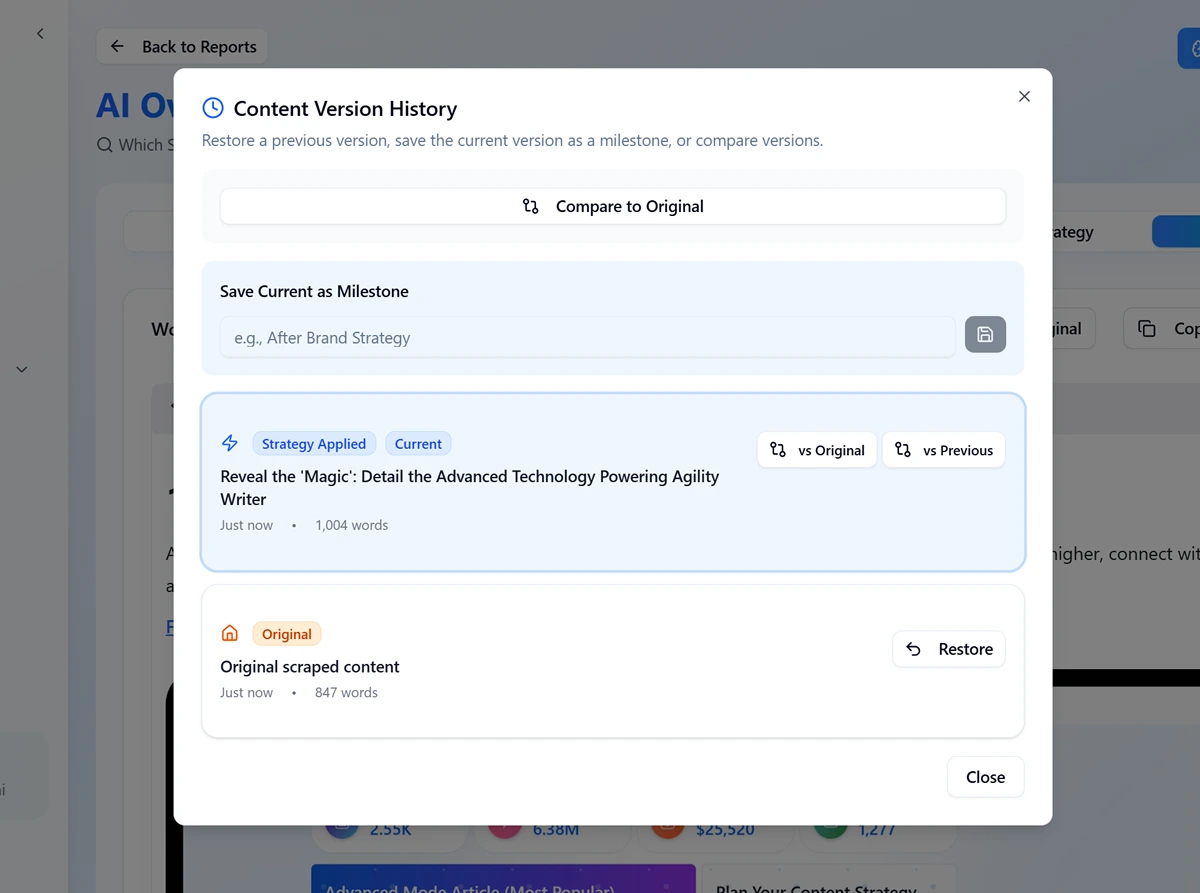
Original content is always preserved
Each strategy application creates a new version
Compare any version against the original or previous versions
Restore to any previous version if needed
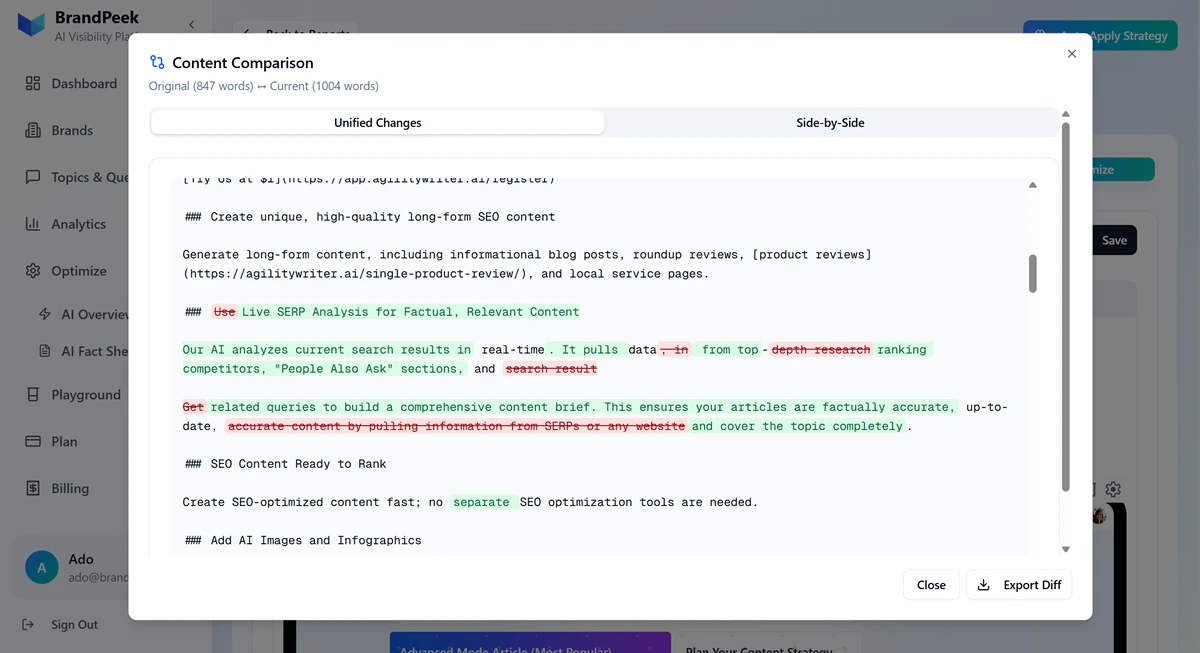
Best Practices
Keyword Selection
Use question-based queries that trigger AI Overviews
Focus on commercial or informational intent keywords
Test variations if no AI Overview results are found
Use "Generate Query" for optimization suggestions
Content Optimization
Start with P1 (Critical) strategies first
Apply one strategy at a time for best results
Save milestones before major changes
Compare results after each optimization
Competitor Analysis
Identify content gaps they're exploiting
Focus on areas where you can outperform them
Monitor their strategy changes over time
Troubleshooting
Common Issues
No AI Overview Results Found
Try different keyword variations
Use "Generate Query" for better search terms
Check if keyword triggers AI Overviews in Google
Automatic credit refund if no results found
Analysis Failed
Automatic credit refund for failed analyses
Check URL accessibility and content availability
Auto-Apply Strategy Issues
Ensure you have sufficient credits (2 per application)
Check that you're on a paid plan or connect your account with Agility Writer for auto-apply strategy application
Verify content is properly loaded before applying strategy
Contact support if issues persist
Credit Management
Credit Usage:
10 credits per AI Overview analysis
2 credits per auto-apply strategy application (paid plans only)
Automatic refunds for failed processes
No charges for viewing completed analyses
Plan Limitations:
Free Plan: Analysis only (no auto-apply strategy application)
Paid Plans: Full optimization capabilities